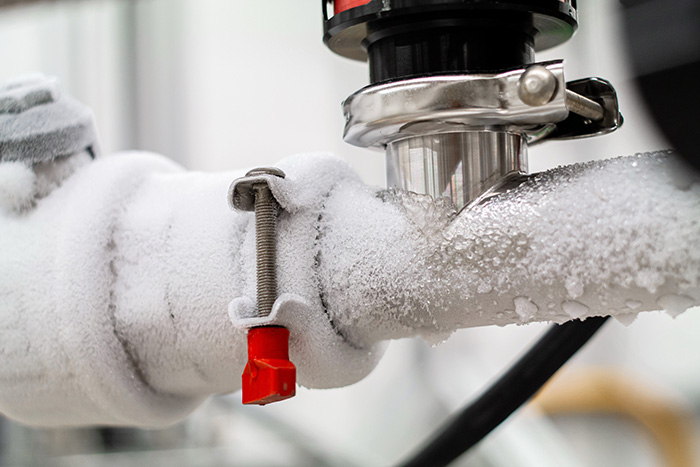The author is making several great points on How To Avoid Freezing Pipes as a whole in this post directly below.

Cold weather can ruin your pipes, specifically by freezing pipes. Right here's just how to stop it from happening and what to do if it does.
Intro
As temperatures drop, the risk of icy pipes increases, possibly causing expensive fixings and water damages. Understanding how to prevent frozen pipes is critical for property owners in chilly climates.
Understanding Icy Pipelines
What triggers pipes to freeze?
Pipelines freeze when exposed to temperatures below 32 ° F (0 ° C) for extended durations. As water inside the pipes freezes, it increases, putting pressure on the pipe wall surfaces and potentially creating them to rupture.
Dangers and problems
Frozen pipes can result in water supply interruptions, property damages, and pricey repair work. Burst pipelines can flooding homes and trigger considerable structural damages.
Indicators of Frozen Pipeline
Recognizing frozen pipes early can avoid them from breaking.
How to determine frozen pipelines
Seek decreased water flow from faucets, uncommon smells or sounds from pipelines, and noticeable frost on revealed pipes.
Avoidance Tips
Shielding at risk pipelines
Cover pipes in insulation sleeves or utilize warmth tape to secure them from freezing temperature levels. Focus on pipes in unheated or outside locations of the home.
Heating techniques
Maintain interior areas sufficiently warmed, specifically locations with plumbing. Open closet doors to permit warm air to flow around pipes under sinks.
Shielding Outdoor Pipes
Yard hoses and outside taps
Detach and drain pipes yard hose pipes prior to winter. Install frost-proof spigots or cover exterior faucets with shielded caps.
What to Do If Your Pipes Freeze
Immediate actions to take
If you believe frozen pipes, maintain taps open to soothe pressure as the ice melts. Utilize a hairdryer or towels taken in warm water to thaw pipelines gradually.
Long-Term Solutions
Structural adjustments
Think about rerouting pipes far from outside wall surfaces or unheated locations. Include added insulation to attic rooms, cellars, and crawl spaces.
Updating insulation
Buy high-quality insulation for pipes, attics, and walls. Proper insulation helps keep regular temperature levels and lowers the danger of frozen pipes.
Conclusion
Preventing frozen pipelines needs positive steps and fast feedbacks. By comprehending the reasons, indicators, and preventive measures, homeowners can safeguard their plumbing throughout winter.
5 Ways to Prevent Frozen Pipes
Drain Outdoor Faucets and Disconnect Hoses
First, close the shut-off valve that controls the flow of water in the pipe to your outdoor faucet. Then, head outside to disconnect and drain your hose and open the outdoor faucet to allow the water to completely drain out of the line. Turn off the faucet when done. Finally, head back to the shut-off valve and drain the remaining water inside the pipe into a bucket or container. Additionally, if you have a home irrigation system, you should consider hiring an expert to clear the system of water each year.
Insulate Pipes
One of the best and most cost-effective methods for preventing frozen water pipes is to wrap your pipes with insulation. This is especially important for areas in your home that aren’t exposed to heat, such as an attic. We suggest using foam sleeves, which can typically be found at your local hardware store.
Keep Heat Running at 65
Your pipes are located inside your walls, and the temperature there is much colder than the rest of the house. To prevent your pipes from freezing, The Insurance Information Institute suggests that you keep your home heated to at least 65 degrees, even when traveling. You may want to invest in smart devices that can keep an eye on the temperature in your home while you’re away.
Leave Water Dripping
Moving water — even a small trickle — can prevent ice from forming inside your pipes. When freezing temps are imminent, start a drip of water from all faucets that serve exposed pipes. Leaving a few faucets running will also help relieve pressure inside the pipes and help prevent a rupture if the water inside freezes.
Open Cupboard Doors
Warm your kitchen and bathroom pipes by opening cupboards and vanities. You should also leave your interior doors ajar to help warm air circulate evenly throughout your home.

We had been guided to that report on How to prepare your home plumbing for winter weather from an associate on a different website. Do you know another individual who is in to the subject? Do not hesitate to share it. We recognize the value of reading our article about Winter Plumbing Precautions: Preventing Frozen Pipes.
At This Website
Comments on “Preventing Frozen Pipes in Cold Weather: Essential Tips”